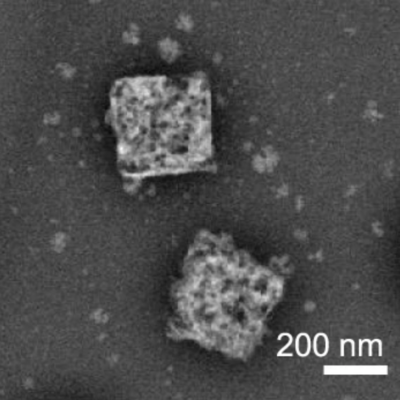Dynamic transformation of cubic copper catalysts during CO2 electroreduction and its impact on catalytic selectivity
Philipp Grosse, Aram Yoon, Clara Rettenmaier, Antonia Herzog, See Wee Chee and Beatriz Roldan Cuenya
Catalysis researchers are constantly looking for new and more effective catalysts. The stability of catalysts plays an important role when it comes to their industrial application. Here, it is good to know that catalysts transform during catalysis - their shape changes as well as their properties. And this may affect their performance! To rationally design effective and stable catalysts, researchers need to understand how catalysts transform under reaction conditions. Moreover, the long-term performance of a catalyst can best be optimized when the underlying relationship between the structure and the properties of the catalyst is known.
The current study monitors the transformation of a catalyst, namely copper(I) oxide cubes, in real time during catalysis. The UniSysCat team around Prof. Beatriz Roldan Cuenya from the Fritz Haber Institute Berlin uses real-time electrochemical liquid cell transmission electron microscopy to show how these cubic copper catalysts restructure during reaction.
The group of Prof. Beatriz Roldan Cuenya is particularly interested in catalysts for energy conversion applications. The cubic copper catalysts have been chosen since they are promising candidates to catalyze the electrochemical reduction of CO2. In this reaction, the greenhouse gas CO2 is transformed into useful fuels and base chemicals, such as ethylene and ethanol, at ambient temperature and pressure. The structure of the copper catalysts may have a crucial impact on the reaction. However, a detailed understanding of this remains difficult due to insufficient insight into the dynamic development of copper catalysts under reaction conditions - which is not easy to measure.
In the current study, the team applied sophisticated transmission electron microscopy methods to track the dynamic evolution of copper cubes in real time under reaction conditions. They observe the dynamic fragmentation of the solid cubes, redeposition of new nanoparticles, catalyst detachment and catalyst aggregation as a function of the applied potential and time. They show that the copper cubes restructure from solid crystals to fragmented nanoporous structures under reaction conditions. A dynamically evolving surface morphology is described, which consists of nanoporous structures created from larger cubes intermixed with redeposited nanoparticles. And the team is able to correlate the structural changes to certain catalytic properties: In particular, they reveal that the dynamic surface morphology can sustain the catalytic selectivity towards hydrocarbons.
These results demonstrate the inherent complexity of real-world catalysts. The authors conclude: "Gaining deeper insight into the long-term stability of nanoscale catalysts is especially important for the advancement of energy conversion technologies as it can lead to the development of novel strategies that make use of these inherent restructuring dynamics to create catalysts with improved performance."
The findings of Grosse et al. have been published as an open access article in Nature Communications: Grosse, P., Yoon, A., Rettenmaier, C., Herzog, A., Chee, S. W., Roldan Cuenya, B. Dynamic transformation of cubic copper catalysts during CO2 electroreduction and its impact on catalytic selectivity. Nat. Comms., 2021, 12, 6736. https://doi.org/10.1038/s41467-021-26743-5

